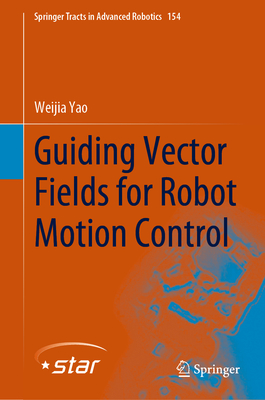You are here
Back to topGuiding Vector Fields for Robot Motion Control (Springer Tracts in Advanced Robotics #154) (Hardcover)
Description
Using a designed vector field to guide robots to follow a given geometric desired path has found a range of practical applications, such as underwater pipeline inspection, warehouse navigation, and highway traffic monitoring. It is thus in great need to build a rigorous theory to guide practical implementations with formal guarantees. It is even so when multiple robots are required to follow predefined desired paths or maneuver on surfaces and coordinate their motions to efficiently accomplish repetitive and laborious tasks.
The book introduces guiding vector fields on Euclidean spaces and Riemannian manifolds for single-robot and multi-robot path-following and motion coordination, provides rigorous theoretical guarantees of vector field guided motion control of robotic systems, and elaborates on the practical implementation of the proposed algorithms on mobile wheeled robots and fixed-wing aircraft. It provides guidelines for the robust, reliable, and safe practical implementations for robotic tasks, including path-following navigation, obstacle-avoidance, and multi-robot motion coordination.In particular, the book reveals fundamental theoretic underpinnings of guiding vector fields and applies to addressing various robot motion control problems. Notably, it answers many crucial and challenging questions such as:
- How to generate a general guiding vector field on any n-dimensional Riemannian manifold for robot motion control tasks?
- Do singular points always exist in a general guiding vector field?- How to generate a guiding vector field that is free of singular points?
- How to design control algorithms based on guiding vector fields for different robot motion control tasks including path-following, obstacle-avoidance, and multi-robot distributed motion coordination?
Answering these questions has led to the discovery of fundamental assumptions, a "topological surgery" to create a singularity-free guiding vector field, a robot navigation algorithm with the global convergence property, a provably safe collision-avoidance algorithm and an effective distributed motion control algorithm, etc
About the Author
Weijia Yao obtained the Ph.D. degree with distinction cum laude in systems and control theory from the University of Groningen, Groningen, the Netherlands, in 2021. He has published more than 20 peer-reviewed journal and conference papers in the robotics and automatic control fields, including IEEE Transactions on Robotics, IEEE Transactions on Automatic Control, IEEE Transactions on Intelligent Transportation Systems, Automatica, IEEE International Conference on Robotics and Automation (ICRA), IEEE Conference on Decision and Control (CDC). He was a finalist for the Best Conference Paper Award at ICRA in 2021, a finalist for the Georges Giralt PhD Award in 2022, the recipient of the Outstanding Master Degree Dissertation award of Hunan province, China, in 2020, and the champion of the technical challenge in 2019 RoboCup Middle Size League. His research interests include mobile robotics, multiagent systems, game theory and nonlinear systems and control.
